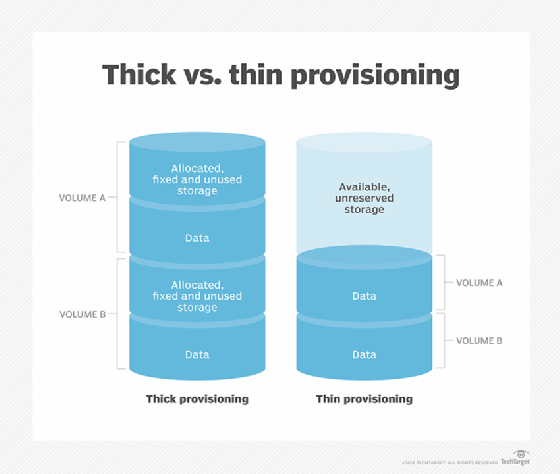
Getty Images/iStockphoto
3 VMware disk types you should know: Raw, thick and thin
Raw, thick and thin disks offer portability and file storage efficiency. But each type has its pros and cons, including slower write speeds, less security and increased capacity.
Virtual disks offer better portability and efficiency for file storage compared to physical disks, which directly access existing local disks or partitions. VMware has three different disk types -- raw, thick and thin -- and they each allocate storage differently.
VMware virtual disks aren't one in the same. Those who know the difference between each disk type and their use cases can ensure their systems allocate storage efficiently without incurring performance issues.
Raw disks create a connection between a storage logical unit number and a VM from a storage area network; they are preferential for guest OS clustering and SAN snapshots.
Thick lazy zeroed disks offer better performance and security while eager zeroed disks offer faster creation speeds. These disks reduce latency by preallocating physical storage on a disk.
Thin disks optimize disk efficiency by allocating disk storage space between multiple users. Thin disks are best for saving disk space and disk efficiency.
Raw disks help improve I/O application performance
A raw disk, also known as raw device mapping (RDM), enables you to directly connect a storage LUN to a VM within a SAN. RDM isn't the only method to set up VM disk access. A Virtual Machine File System (VMFS) can configure disk access, though RDM is best for cluster configurations between VMs, physical devices and VMs, or SAN-aware applications within a VM.
RDM doesn't store a VM's disk data on a VMFS volume; it stores a VM's disk data on a small disk descriptor file within the VM's working directory that resides on the VMFS volume. RDM uses SAN commands and can improve I/O-intensive applications' overall performance.
You can configure RDM in two modes: virtual compatibility or physical compatibility mode. Virtual compatibility offers advanced file locking and snapshots. Physical compatibility offers access to almost all hardware functions of the mapped storage system.
Thick disks boost performance and security
Thick disks use thick provisioning to preallocate physical storage once you create a disk. If you create a 50 GB virtual disk, that disk would consume exactly 50 GB of physical disk space. This disk space is then unavailable to any other disk or VM. There are two thick disk types: thick provision lazy zeroed and thick provision eager zeroed.
Thick provision lazy zeroed disks. A thick provision lazy zeroed disk allocates all its disk space when you create it. The caveat is the lazy zeroed disk might contain old data from physical media. This requires the disk to zero out on command before you can write new data onto the disk's blocks. Lazy zeroed disk creation is fast, but often lacks performance because of increased IOPS.
Thick provision eager zeroed disks. A thick provision eager zero disk creates VM disks in a default thick format and allocates the maximum required disk space upon creation. The allocated disk space doesn't contain previous data on the physical media. Eager zeroed disks support VMware Fault Tolerance, but they take longer to create because the system writes zeroes on the entire disk; these first writes offer faster performance.
Thin disks optimize disk efficiency
Thin disks use thin provisioning to optimize space use in SAN. Thin disks only consume the amount of disk space they require to function. The amount of disk space they require grows over time as the guest OS assigns more I/O to the thin disk. For example, if you create an 8 GB thin disk, the disk only consumes 1 GB initially and uses up to a maximum of 8 GB as it grows.
Thin provisioning does have drawbacks. The process can lead to an unusable VM, which occurs when multiple VMs that contain thin provisioned disks consume almost all their allocated disk space. If the disks consume all allocated space, then all VMs fail. You must then migrate those VMs to a different datastore to get them back up and running.
You can thin provision at the back end or at the hypervisor side. Thin provisioning at the back end -- if your storage array supports it -- can help save disk space. Thin disks will only consume what they require, rather than consume the maximum spaced allocated to them -- which results in Capex savings.
Hypervisor side thin provisioning is preferable in situations where the system overcommits disk space when you deploy more VM disk files (VMDKs) than overall available disk space. Another use case is when your local storage doesn't support back-end thin provisioning.
Thin provisioned vs. thick provisioned
Thin and thick provisioned disks offer similar storage capabilities, but they do have differences. Thin disks allocate storage space on demand up until the disk reaches its maximum required amount, while thick disks allocate the entirety of required storage space at the time of creation.
Thin disks are best for saving disk space at creation. Thin disks let you overcommit disk space to a VM and add physical storage as needed. But this can lead to VM failure if you don't add the physical storage before the disk consumes its maximum space allocation.
Thick provision eager zeroed disks offer performance and security but require sufficient storage space and take longer to create, despite faster initial write speeds. Thick provision lazy zeroed disk creation is quicker compared to eager zeroed disks, but they don't offer fast speeds during initial creation and aren't as secure.









